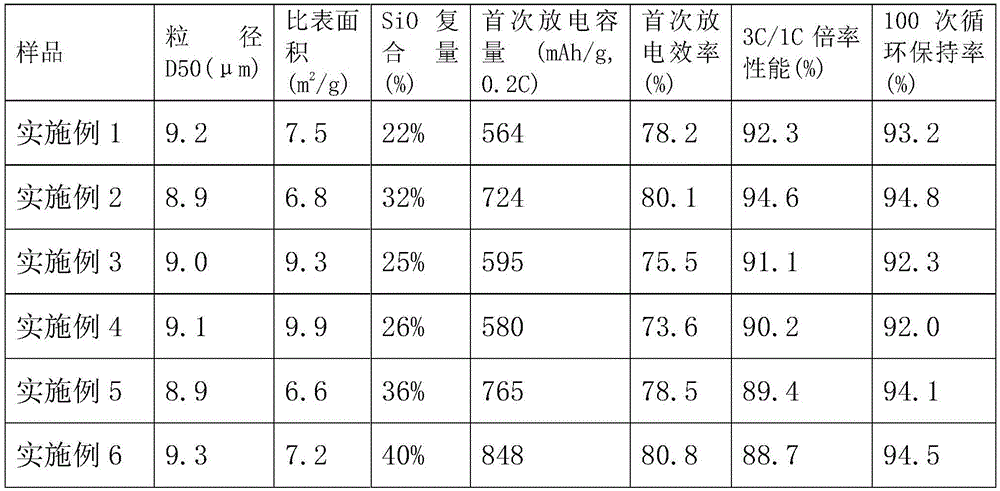Preparation method of high capacity lithium ion battery hard carbon composite negative electrode material
A technology for lithium ion batteries and negative electrode materials, applied in battery electrodes, circuits, electrical components, etc., can solve the problems of low discharge voltage, low initial efficiency, low reversible capacity, etc., achieving easy operation, short production cycle, and wide source of raw materials Effect
- Summary
- Abstract
- Description
- Claims
- Application Information
AI Technical Summary
Problems solved by technology
Method used
Image
Examples
Embodiment 1
[0027] (1) Mixing of raw materials: crush petroleum asphalt with a softening point of 120°C through a 100-mesh sieve, and uniformly mix 276g of silicon oxide with D50=3μm, 400g of paraformaldehyde and 2000g of petroleum asphalt powder in a high-speed mixer , to prepare mixed powder;
[0028] (2) Cross-linking polymerization reaction: Then feed the mixed powder and 100g p-toluenesulfonic acid into the reactor, and under nitrogen protection and stirring conditions, raise the temperature to 180°C for cross-linking polymerization reaction for 4 hours to obtain a cross-linked polymer Certainly in this step, the mixing of mixed powder and p-toluenesulfonic acid can also be completed together in the above-mentioned "raw material mixing" step;
[0029] (3) High-temperature curing treatment: under the protection of nitrogen, the cross-linked polymer was heated to 300°C for curing treatment for 2 hours, then cooled to room temperature and discharged, the obtained product was mechanicall...
Embodiment 2
[0034] (1), raw material mixing: crush the petroleum asphalt with a softening point of 120°C through a 100-mesh sieve, mix 472g, D50=3μm silicon oxide, 600g paraformaldehyde and 2000g of the petroleum asphalt powder in a high-speed mixer Mix to obtain mixed powder;
[0035] (2) Cross-linking polymerization reaction: Then feed the mixed powder and 100g p-toluenesulfonic acid into the reaction kettle, raise the temperature to 180°C for 4 hours under the protection of nitrogen and stirring to carry out the cross-linking polymerization reaction to obtain cross-linking polymerization thing;
[0036] (3) High-temperature curing treatment: under the protection of nitrogen, the cross-linked polymer was heated to 300°C for curing treatment for 2 hours, then cooled to room temperature and discharged, the obtained product was mechanically crushed and passed through a 150-mesh sieve, and the under-sieve was obtained. first powder;
[0037] (4) Pre-carbonization treatment: put the first ...
Embodiment 3
[0041] (1), raw material mixing: 2000g is pre-mixed with 8wt% urotropine, that is, hexamethylenetetramine, and the thermoplastic phenolic resin powder with a softening point of 90°C is mixed with D50 in a high-speed mixer = 425g of silicon dioxide with a thickness of 3 μm was uniformly mixed to obtain a mixed powder;
[0042] (2) Cross-linking polymerization reaction: Feed the mixed powder into the reactor, under nitrogen protection and stirring conditions, raise the temperature to 150°C for cross-linking polymerization for 4 hours to obtain a cross-linked polymer;
[0043] (3) High-temperature curing treatment: under the protection of nitrogen, the cross-linked polymer was heated to 250°C for curing treatment for 2 hours, then cooled to room temperature and discharged, the obtained product was mechanically crushed and passed through a 150-mesh sieve, and the under-sieve was obtained. first powder;
[0044] (4) Pre-carbonization treatment: put the first powder into a well-typ...
PUM
| Property | Measurement | Unit |
|---|---|---|
| density | aaaaa | aaaaa |
| density | aaaaa | aaaaa |
| specific surface area | aaaaa | aaaaa |
Abstract
Description
Claims
Application Information
 Login to View More
Login to View More - R&D
- Intellectual Property
- Life Sciences
- Materials
- Tech Scout
- Unparalleled Data Quality
- Higher Quality Content
- 60% Fewer Hallucinations
Browse by: Latest US Patents, China's latest patents, Technical Efficacy Thesaurus, Application Domain, Technology Topic, Popular Technical Reports.
© 2025 PatSnap. All rights reserved.Legal|Privacy policy|Modern Slavery Act Transparency Statement|Sitemap|About US| Contact US: help@patsnap.com


